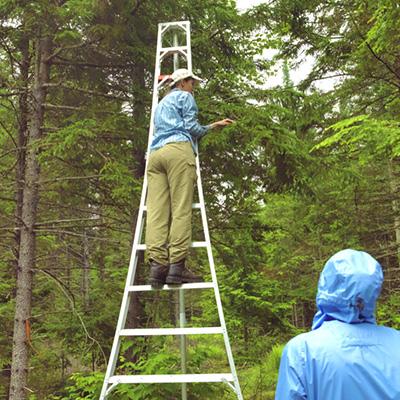Influence of Commercial Thinning on Resistance to and Recovery from Defoliation in Spruce-Fir Forests

Eastern spruce budworm has plagued spruce-fir forests for centuries and causes widespread defoliation, loss of productivity, and tree mortality. A tree’s capacity to recover after consecutive years of defoliation depends on its reserves of nonstructural carbohydrates (sugars and starch) available to stimulate new growth of foliage. While commercial thinning has the potential to increase growth of foliage and production of sugars, studies show that thinning has a complicated effect on budworm outbreak severity and duration. Secondary defense compounds, such as tannic acid, produced by the tree may provide resistance to budworm and other defoliators.
NSRC researchers evaluated the responses of red spruce and balsam fir to thinning and artificial defoliation treatments on three experimental sites across Maine. Researchers measured nonstructural carbohydrates in branches, stems, and roots of trees in both thinned and unthinned forest plots. They artificially defoliated branches in thinned plots to mimic effects of defoliation.
Researchers found that stand-level thinning treatments lower nonstructural carbohydrates available to both spruce and fir with the largest decreases in the branches – reserves most accessible for supplying carbohydrates to developing foliage. This could leave trees within thinned stands vulnerable during a budworm outbreak. Artificial defoliation treatments did not stimulate production of defensive compounds in either spruce or fir. Interestingly, balsam fir maintained higher concentrations of nonstructural carbohydrates and foliar tannic acid than did red spruce. These findings suggest that balsam fir is better adapted to withstand defoliation caused by the spruce budworm; however, this is not the trend that has been reported historically when defoliation and mortality of the species were compared.
